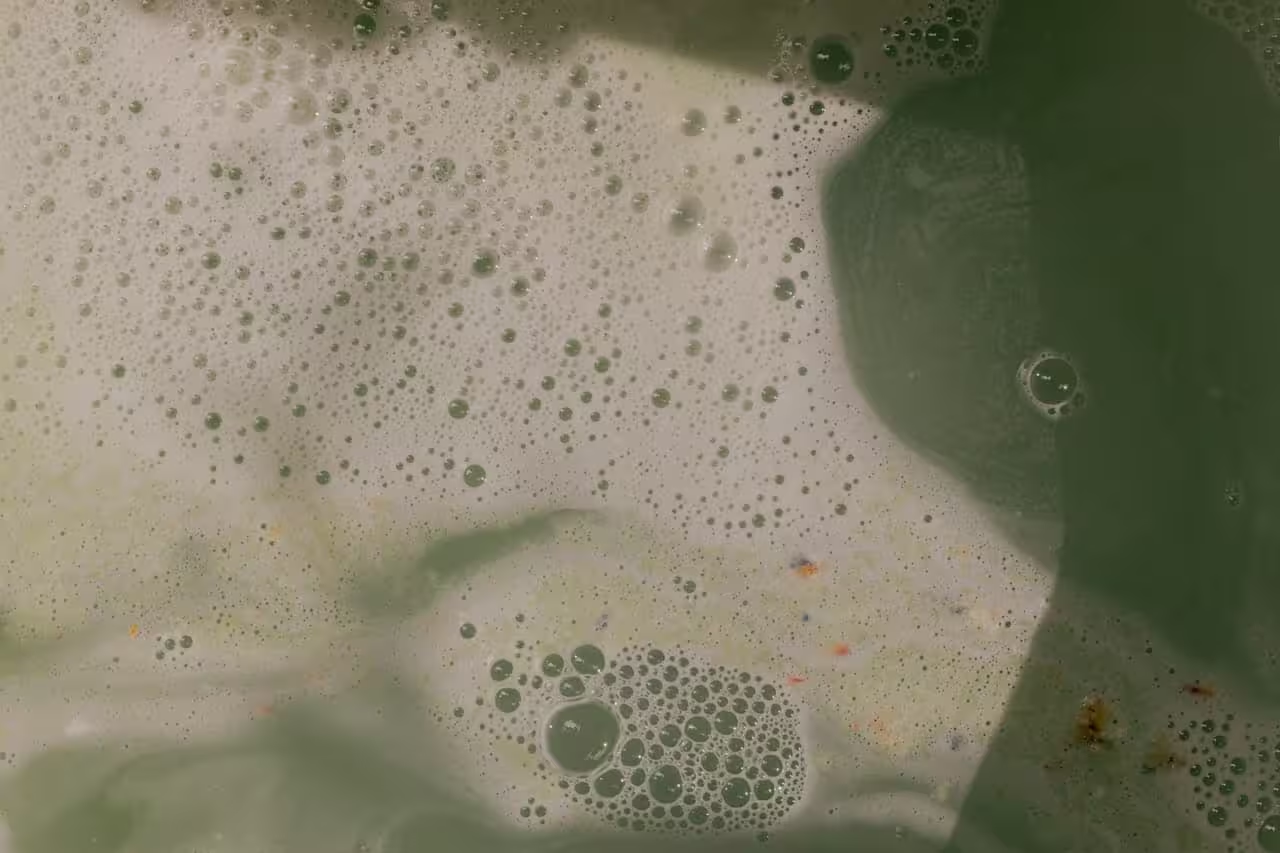

Frothy Vaginal Discharge: What It Means and When to Test
Frothy discharge may signal bacterial vaginosis or trichomoniasis. Learn what’s normal, and how Evvy’s test can help uncover the cause of vaginal changes.
Words by Olivia Cassano
Scientifically edited by Dr. Krystal Thomas-White, PhD
Medically reviewed by Dr. Kate Stewart, MD
Vaginal discharge is a fickle thing. It’s pretty normal for the texture, color, and quantity of it to vary slightly from time to time, but sometimes those changes can be your vagina’s way of sounding the alarm. There are some telltale signs that you might be dealing with a vaginal infection, and one of those signs is abnormal vaginal discharge.
If you’ve noticed frothy vaginal discharge, it’s a good idea to call your healthcare provider. But why is it there in the first place? What does frothy discharge mean? Keep scrolling to learn more.
Is frothy discharge normal?
The short answer is no. Healthy vaginal discharge exists in a spectrum, so what is normal for you will probably be different from what’s normal for your friend, sister, partner, etc. After all, no two vaginal microbiomes are the same, so “normal” vaginal discharge can look different from person to person. Having said that, healthy vaginal discharge shouldn’t be frothy. Normal vaginal discharge should look clear or white and have a creamy, milky, or stretchy consistency.
If you’re not on a form of hormonal birth control, the look and smell of your vaginal discharge changes throughout the month in response to the normal hormonal fluctuations of the menstrual cycle. Tracking your vaginal discharge and getting accustomed to what “normal” looks for your body can help you spot something wrong. In general, some warning signs to look out for are:
- A drastic change in color or consistency that is unusual for you.
- A sudden bad smell. Note: it’s normal for vaginal discharge to have a mild smell, but you shouldn’t ignore a really noticeable or foul odor.
- An unusually large amount of vaginal discharge. If you’re not on hormonal birth control, it’s normal to have more vaginal discharge mid-cycle, around the time of ovulation.
- Other symptoms, such as a burning sensation, vaginal irritation.
- Pelvic pain.
- Vaginal bleeding between periods or after sex.
Several vaginal infections and sexually transmitted infections (STIs) can cause these symptoms, so it's really important to call your healthcare provider to get a proper diagnosis.

Recurrent symptoms? Get Evvy's at-home vaginal microbiome test, designed by leading OB-GYNs.
What does frothy discharge look like?
Frothy vaginal discharge looks like a thin or thick fluid with lots of tiny air bubbles — like soap suds, but definitely less pleasant.
Types of frothy discharge
- Green frothy vaginal discharge
- Yellow frothy vaginal discharge
- White frothy vaginal discharge
- Gray frothy vaginal discharge.
Regardless of the color, frothy vaginal discharge is a sign of an infection — especially if it has a foul or fishy odor.
What causes frothy discharge?
Foamy discharge is a common symptom of trichomoniasis, a type of sexually transmitted infection (STI).
Trichomoniasis, or “trich” for short, happens when a tiny parasite called Trichomonas vaginalis (TV) enters your reproductive tract and disrupts the natural balance of your vaginal pH, causing an infection. You can contract trich through sexual contact or by coming into contact with sexual fluids (like when sharing sex toys).
Trichomoniasis is an incredibly common sexually transmitted infection and can affect anyone who is sexually active. Like most STIs, it doesn’t usually cause symptoms, and around 70% of people with trichomoniasis don't experience any signs or symptoms at all, according to the Centers for Disease Control (CDC).
When symptomatic, however, it’s characterized by a frothy yellowish-green discharge with a foul or fishy odor and a pH above 4.5.
Aside from abnormal vaginal discharge, trichomoniasis symptoms might include:
- Vaginal itching or irritation
- Pain or burning when peeing
- The frequent need to pee
- Spotting or bleeding between periods
- Pain during sex.
See your healthcare provider if you notice any of these symptoms or take an STI test. Remember that trichomoniasis tests aren't always included in routine STI panels, so you may need to request them specifically. You can also opt for an at-home STI test to screen for trichomoniasis, such as Evvy’s Expanded PCR Panel and Vaginal Health Test. Testing for trichomoniasis at home involves taking a simple vaginal swab and then sending the results to a lab to get analyzed (much like with an in-clinic test) without an in-person doctor’s visit.
If your test results come back positive, don’t panic! Trich is easily treated with antibiotics, and the infection should clear up within a week with correct treatment. Sexual partners should be treated too to prevent the further spread of the infection (and to prevent getting the infection again after treatment).
Can BV or yeast infections cause frothy discharge?
Yes, bacterial vaginosis can sometimes cause frothy vaginal discharge, though a frothy or bubbly texture is more classically associated with trichomoniasis. That said, vaginal discharge can vary a lot from person to person, and infections like bacterial vaginosis or even a vaginal yeast infection can sometimes present in ways that overlap or feel unusual, including a frothy appearance.
Yeast infections typically cause thick, white discharge that resembles cottage cheese and is usually odorless. It's often accompanied by intense itching, redness, and irritation around the vulva. In contrast, bacterial vaginosis discharge is usually thin, watery, gray or off-white, and has a strong fishy odor, especially after sex. Frothy discharge may also show up in bacterial vaginosis cases, particularly when there's a lot of inflammation or imbalance, but it’s not the hallmark feature.
Because so many symptoms can overlap — and because vaginal discharge appearance alone isn’t enough to diagnose the cause — it’s important to consider other signs like smell, itching, burning, and when symptoms appear during your cycle. If you’re noticing frothy discharge along with discomfort or an unusual odor, it's worth investigating further.
Evvy’s Vaginal Health Test can help by identifying the bacterial and fungal species present in your vaginal environment, giving you detailed insight into what might be driving symptoms like frothy discharge, including imbalances linked to bacterial vaginosis, yeast overgrowth, or disruptions that could make you more susceptible to infections like trichomoniasis. With the right information, you and your healthcare provider can make more informed decisions about treatment and care.
FAQs
What does white frothy discharge mean?
White frothy vaginal discharge is most likely a symptom of trichomoniasis, a very common STI caused by a tiny parasite. Trichomoniasis discharge is foamy and can also be gray or greenish. You should see your healthcare provider if you have white frothy discharge.
Does BV cause frothy discharge?
Bacterial vaginosis doesn’t usually cause frothy discharge, but it can happen. Bacterial vaginosis typically causes thin, watery gray discharge that is fishy or foul-smelling.
Is chlamydia discharge frothy?
One of the main symptoms of chlamydia is yellow or white, thick, or milky discharge with a strong, unpleasant odor. Chlamydia discharge doesn’t usually have a foamy consistency, but sometimes it might look clumpy and similar to a yeast infection.
What causes green, frothy, foul-smelling discharge?
Green, frothy, foul-smelling vaginal discharge is most commonly caused by trichomoniasis, an STI caused by the parasite Trichomonas vaginalis. This type of discharge is often described as bubbly or foamy, yellow-green to green in color, and has a strong, unpleasant odor, sometimes fishy or musty. It may be accompanied by other symptoms like itching, burning during urination, vaginal redness, or discomfort during sex, though some people have no symptoms at all.





